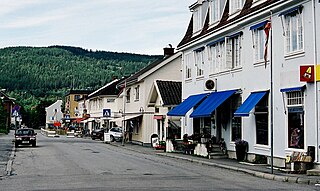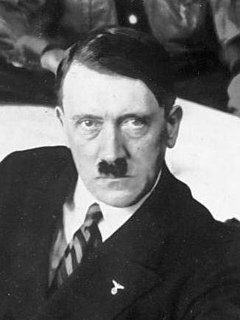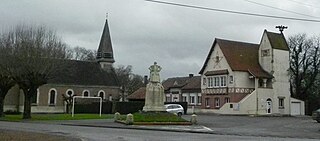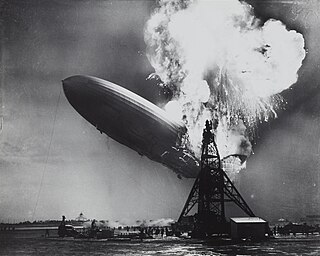
Paul Ludwig Hans Anton von Beneckendorff und von Hindenburg was a German field marshal and statesman who led the Imperial German Army during World War I and later became President of Germany from 1925 until his death in 1934. During his presidency, he played a key role in the Nazi seizure of power in January 1933 when, under pressure from advisers, he appointed Adolf Hitler as Chancellor of Germany.

Zabrze is an industrial city in Silesia in southern Poland, near Katowice. The west district of the Silesian Metropolis, a metropolis with a population of around 2 million. It is in the Silesian Highlands, on the Bytomka River, a tributary of the Oder.

Jevnaker is a municipality in Viken county, Norway. The administrative centre of the municipality is the village of Jevnaker with a population of 4,302.

Lunner is a municipality in Viken county, Norway. It is part of the traditional region of Hadeland. The administrative centre of the municipality is the village of Roa. Lunner was established when it was separated from the municipality of Jevnaker on 1 January 1898. From 1 January 2020 the municipality belongs to Viken county, it was Oppland before that.
A Verbandsgemeinde is a low-level administrative unit in the German federal states of Rhineland-Palatinate and Saxony-Anhalt. A Verbandsgemeinde is typically composed of a small group of villages or towns.

The Hindenburg Line was a German defensive position built during the winter of 1916–1917 on the Western Front during the First World War. The line ran from Arras to Laffaux, near Soissons on the Aisne. In 1916, the Battle of Verdun and the Battle of the Somme left the German western armies exhausted and on the Eastern Front, the Brusilov Offensive had inflicted huge losses on the Austro-Hungarian armies and forced the Germans to take over more of the front. The declaration of war by Romania had placed additional strain on the German army and war economy.

Federal elections were held in Germany on 6 November 1932. The Nazi Party saw its vote share fall by four percentage points, while there were slight increases for the Communist Party of Germany and the national conservative German National People's Party. The results were a great disappointment for the Nazis, who lost 34 seats and again failed to form a coalition government in the Reichstag. The elections were the last free and fair all-German election before the Nazi seizure of power in 1933. The next free elections would not be held in West Germany until 1949 and no further free election for the entire country would occur prior to 1990.

Templin is a small town in the Uckermark district of Brandenburg, Germany. Though it has a population of only 17,127 (2006), in terms of area it is, with 377.01 km2, the second largest town in Brandenburg and the seventh largest town in Germany. The town is located in the south of the rural Uckermark region and its capital Prenzlau, north of the Schorfheide-Chorin Biosphere Reserve. The municipality comprises the villages of Ahrensdorf, Bebersee, Beutel, Densow, Gandenitz, Gollin, Gross Dölln, Gross Väter, Grunewald, Hammelspring, Herzfelde, Hindenburg, Klosterwalde, Petznick, Röddelin, Storkow and Vietmannsdorf.

Bullecourt is a commune in the Pas-de-Calais department in the Hauts-de-France region in France.

The Battle of St. Quentin Canal was a pivotal battle of World War I that began on 29 September 1918 and involved British, Australian and American forces operating as part of the British Fourth Army under the overall command of General Sir Henry Rawlinson. Further north, part of the British Third Army also supported the attack. South of the Fourth Army's 19 km (12 mi) front, the French First Army launched a coordinated attack on a 9.5 km (6 mi) front. The objective was to break through one of the most heavily defended stretches of the German Siegfriedstellung, which in this sector used the St Quentin Canal as part of its defences. The assault achieved its objectives, resulting in the first full breach of the Hindenburg Line, in the face of heavy German resistance. In concert with other attacks of the Grand Offensive along the length of the line, Allied success convinced the German high command that there was little hope of an ultimate German victory.

Havrincourt is a commune in the Pas-de-Calais department in Hauts-de-France in France. The inhabitants are called Havrincourtois.

The Hindenburg disaster was an airship accident that occurred on May 6, 1937, in Manchester Township, New Jersey, United States. The German passenger airship LZ 129 Hindenburg caught fire and was destroyed during its attempt to dock with its mooring mast at Naval Air Station Lakehurst. The accident caused 35 fatalities from the 97 people on board, and an additional fatality on the ground.

Hargesheim is an Ortsgemeinde – a municipality belonging to a Verbandsgemeinde, a kind of collective municipality – in the Bad Kreuznach district in Rhineland-Palatinate, Germany. It belongs to the Verbandsgemeinde of Rüdesheim, whose seat is in the municipality of Rüdesheim an der Nahe. Hargesheim is a state-recognized tourism community.
Benkendorf is a village and a former municipality in the district Altmarkkreis Salzwedel, in Saxony-Anhalt, Germany. Since 1 January 2009, it is part of the town Salzwedel. It derives its name from the ancient noble Benkendorf family, who descend from Johannes De Benkendorpe who lived around the year 1240. They are considered to be one of the oldest and most respected lower noble families in Germany. Variations in spelling include, Benkendorf(f), Benckendorf(f), Beneckendorf(f), Beckendorf(f), von Benkendorf(f) und von Hindenburg, von Beneckendorf(f) und von Hindenburg and several others. Some of the branches use the predicate of von, others however do not.

Hohenberg-Krusemark is a municipality in the district of Stendal, in Saxony-Anhalt, Germany. It is about 17 km North East of the town Stendal.

Operation Alberich was the code name of a German military operation in France during the First World War. Two salients had been formed during the Battle of the Somme in 1916 between Arras and Saint-Quentin and from Saint-Quentin to Noyon. Alberich was planned as a strategic withdrawal to new positions on the shorter and more easily defended Hindenburg Line. General Erich Ludendorff was reluctant to order the withdrawal and hesitated until the last moment.

Ogrodzieniec is a village in the administrative district of Gmina Kisielice, within Iława County, Warmian-Masurian Voivodeship, in northern Poland.
The administrative divisions of Ohio are counties, municipalities, townships, special districts, and school districts.

















